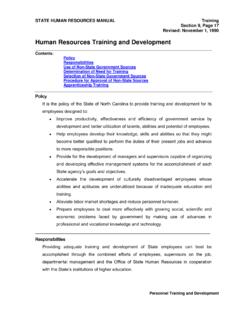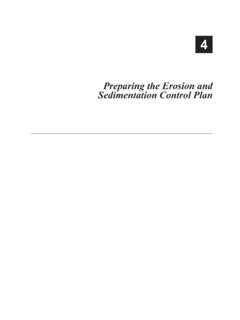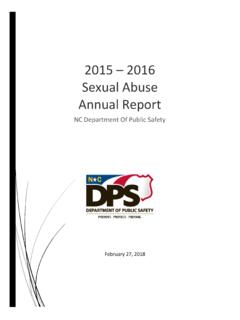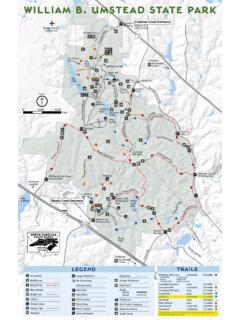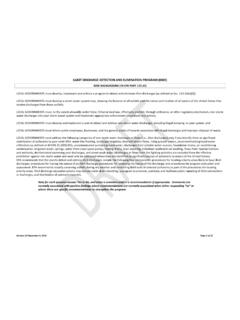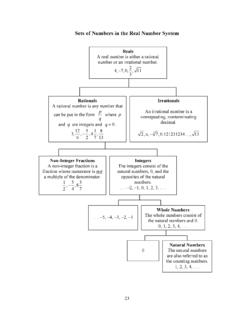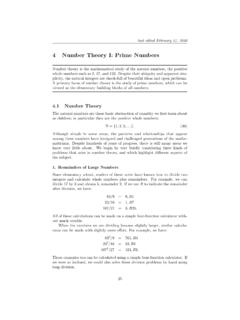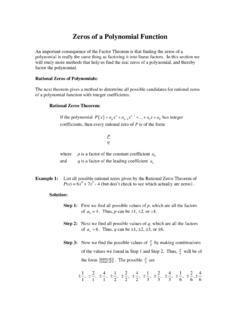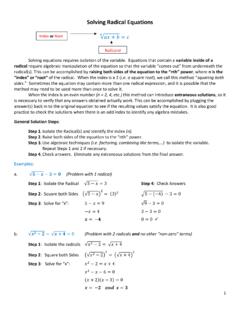Transcription of B. Stormwater Calculations - NC
1 NCDEQ Stormwater Design Manual _____ B. Stormwater Calculations 1 Revised: 3-15-2017 B. Stormwater Calculations Stormwater programs in North Carolina require high density projects to treat the design storm depth in a Stormwater control measure (SCM). To size the SCM, the designer must calculate the volume of runoff that will drain to it. Additional Calculations are needed to design the outlet structures of SCMs. The Stormwater rules do not reference any calculation methods. This chapter provides technical guidance for Stormwater calculation methods that are typically used in North Carolina.
2 Table of Contents rational Method for Peak Flow Simple Method for Runoff Volume Discrete NRCS Curve number Method for Runoff Depth Stage-Storage Tables for Storage Volume of Ponds Weir Equations for Outlet Flow Orifice Equation for Outlet Flow Chainsaw Routing for Stage-Storage-Discharge Other Models for Stage-Storage-Discharge Manning Equation for Channel Flow rational Method for Peak Flow Qp = C * I * A Where: Qp = Peak flow for the storm of interest (cfs) C = Composite runoff coefficient (unitless) I = Rainfall intensity for the storm of interest (in/hr) A = Drainage area (ac) The peak flow is often calculated using the rational Method.
3 Calculating the peak flow is an important design step in designing a flow-based device such as a level spreader-filter strip. It is also important to meet SA waters requirements per 15A NCAC 02H .1019. The composite runoff coefficient, C, reflects the runoff potential of the drainage area. The range of runoff coefficients varies from to , with higher values corresponding to greater runoff potential. The composite runoff coefficient is the weighted average of all of the land uses within the drainage area. Table 1 presents values of runoff coefficients for various surfaces. The rational Method is most applicable to drainage areas that are 20 acres or less.
4 NCDEQ Stormwater Design Manual _____ B. Stormwater Calculations 2 Revised: 3-15-2017 Table 1: rational Runoff Coefficients by Land Use (ASCE 1975, Viessman, et al. 1996, and Malcom 1999) Description of Surface rational Runoff Coefficient, C Unimproved Areas Asphalt Concrete Brick Roofs, inclined Roofs, flat Lawns, sandy soil, flat (<2%) Lawns, sandy soil, average (2-7%) Lawns, sandy soil, steep (>7%) Lawns, heavy soil, flat (<2%) Lawns, heavy soil, average (2-5%) Lawns, heavy soil, steep (>7%) Wooded areas The rainfall intensity in inches per hour, I, can be obtained from the NOAA web site.
5 From this web site, select from one of NOAA s numerous data stations throughout the state and select precipitation intensity. This will open a table that displays precipitation intensity estimates for various annual return intervals (ARIs) (one year through 1,000 years) and various storm durations (5 minutes through 60 days). The requirements of the applicable Stormwater program will determine the appropriate values for ARI and storm duration. If the design is for a level spreader that is receiving runoff directly from the drainage area, then the value for I should simply be one inch per hour (more information on level spreader design in Chapter 8).
6 Simple Method for Runoff Volume RV = + * IA Where: RV = Runoff coefficient (unitless) IA = Impervious fraction (unitless) DV = 3630 * RD * RV * A Where: DV = Design volume (cu ft) RD = Design storm depth (in) A = Drainage area (ac) NCDEQ Stormwater Design Manual _____ B. Stormwater Calculations 3 Revised: 3-15-2017 There are two methods that are often used to determine the volume of runoff from a given design storm: the Simple Method (Schueler 1987) and the discrete NRCS Curve number Method (NRCS 1986).
7 The Simple Method was developed by measuring the runoff from many watersheds with known impervious areas and curve-fitting a relationship between percent imperviousness and the fraction of rainfall converted to runoff (the runoff coefficient). It uses a minimal amount of information to estimate the volume of runoff. A couple of notes on the variables in the Simple Method: The runoff coefficient, RV, is the runoff depth in inches divided by the rainfall depth in inches. The impervious fraction, IA, is the impervious portion of drainage area in acres divided by the drainage area in acres The design volume, DV, is the volume of runoff that must be controlled for the design storm.
8 The design storm depth, RD, is in Coastal Counties and elsewhere. In SA waters, the DV is the difference between runoff volume pre- versus post-development for the 10-year storm. The drainage area, A, must include all of the surfaces that drain to the SCM regardless of whether they are on-site or off-site. Discrete NRCS Curve number Method for Runoff Depth Where: S = Maximum retention after rainfall begins (in) CN = Curve number (unitless) Where: Q* = Runoff depth (in) P = Rainfall depth (in) The steps for using the Discrete NRCS Curve number Method are as follows: 1. Divide the drainage area into land uses and assign an appropriate curve number , CN, to each one (see Table 4).
9 The CN is a value between 30 and 98 that characterizes the amount of runoff generated by a drainage area based on its USGS Hydrologic Soil Group (HSG) and ground cover. 2. Determine the precipitation depth, P. P is in Coastal Counties and elsewhere. In SA waters, the DV is the difference between runoff volume pre- versus post-development for the 10-year storm (read value from the NOAA web site, using a storm duration equal to the time of concentration). NCDEQ Stormwater Design Manual _____ B. Stormwater Calculations 4 Revised: 3-15-2017 3.
10 Compute runoff depth, Q*, for any built upon areas that are directly linked to surface waters via a swale or pipe using the formulas above (note that the CN for built-upon area is 98). Find the runoff volume from the directly connected impervious surfaces by multiplying Q* in inches times the area of the directly connected impervious surfaces in square feet and dividing by 12. 4. Compute runoff depth, Q*, for the remainder of the project. First, calculate a composite CN (a weighted average of the CNs from the land uses). If the CN is equal to or below 64, assume that there is no runoff resulting from either the or storm.




